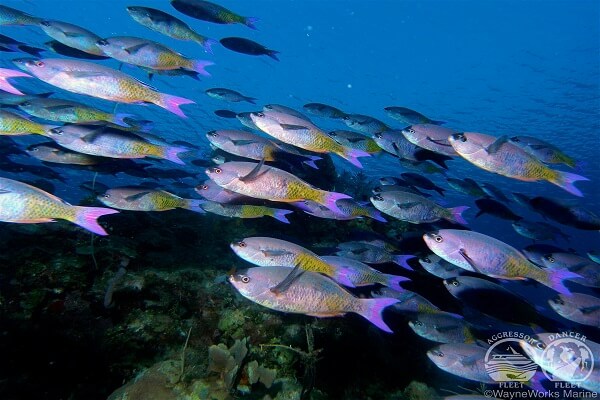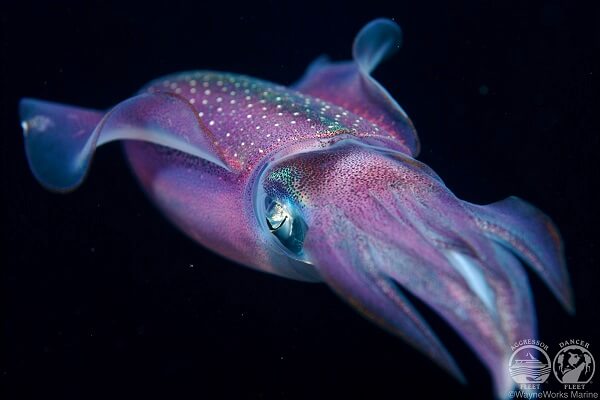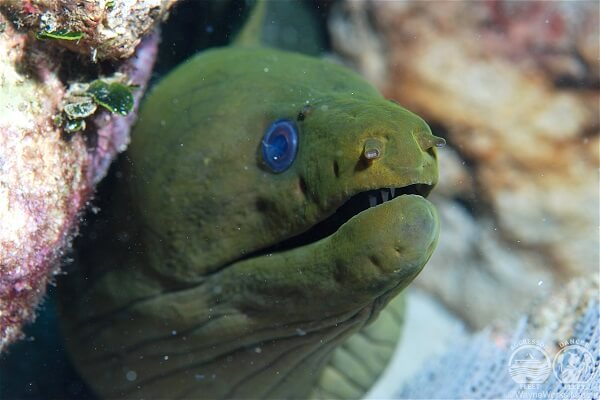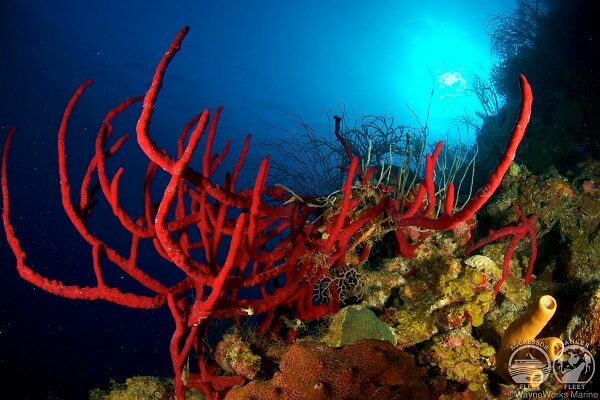Belize

Why
Belize is considered a paradise for vertical walls diving enthusiasts. Awesome
wall sites covered with many colorful soft corals, such as giant gorgonian and
orange elephant ears, are just some of the typicalvistas. In every cave and crack,
crabs, moray eels, lobsters and other creatures hide.
The famous and mystical Blue Hole of Belize was announced by Jacques Cousteau in
1971 as one of the 10 most beautiful diving destinations in the world. This amazing
structure, created with fresh water, is about 300 meters wide and 100 meters deep. We
will dive in this site and enjoy the unique configurations of the columns and stalactites.
Belize is a friendly and pleasant country located in Central America on the Caribbean
Sea, offering high-end touristic and leisure services.

When
The tropical weather in Belize allows visiting all year round, however, the recommended
months to visit Belize are during the dry season between December and April. In the rainy
season, between May and November temperatures are so comfortable that in fact there is
never an off-season period.
The tourist season is the dry one and harder to find accommodation, with competitive prices
in the tourist sites, diving ships and hotels. It is worth remembering that in the wet season
there may also be hurricanes and following updates on the weather condition is recommended.

How
Most major airlines land in Belize. The preferred arrival is usually via USA. The boats Belize
Aggressor III & Sun Dancer II are part of the Aggressor fleet which we represent in Israel.
These are comfortable and pampering ships offering American-style service. A liveaboard
travels from one spectacular site to another allowing for the ultimate vacation and coverage
of vast sea areas.Boarding the liveaboard is in Belize City and so is the departure. You can
of course arrive a day or more ahead of the boarding date and tour the area. Boarding and
departing are on Saturdays, boarding starts from 16:00 and debarking is in the morning.
כללי על היעד










אופי הצלילות










מה רואים


















































The Blue Hole
One of the most beautiful diving sites in the world! (Even according to Jacques Cousteau
who discovered it...) The hole, which happens to be the largest in the world, was created
as a result of the rise in the global water level after the Ice Age. It’s almost a perfect shape,
with about three hundred meters wide and about 125 meters deep. During the dive we will
enjoy the magic of the mysterious cave, watch the formations of the unique reefs, and swim
around the reef sharks.
Level: Suitable for all diving levels.
Depth: maximum 30 m.
Half Moon Caye Wall
A beautiful wall dive that begins on shallow sandy sand with amazing seaweed carpets and
an eel garden. The reef begins with the wall descending 20-30 m, where the most spectacular
corals grow, such as soft and sponge coral. Here you can meet many reef fish, turtles and sea
bats. On the side facing the open sea you can meet manta rays, sharks and more.
Level: Suitable for all diving levels.
Depth: 8-30 m.
Caye Aquarium
This site is considered one of the most beautiful preserved places on the Great Barrier Reef
of Belize. A steep slope that starts at 8 meters reaches an impressive and rare cluster of
sponge and soft corals, mainly gorgonian (fans) which cover the slope and descends steeply.
Reef sharks, large groupers, turtles and sea bats, as well as young fish can be spotted here,
which find their hiding place on the shallow site.
Level: Suitable for all diving levels.
Depth: 8-30 m.
Shark Ray Alley
In the past, local fishermen used to clean their fish in this area, which until today
still attracts sharks and rays. The amazing and impressive creature have become
accustomed to the presence of divers and snorkels on the site.
Level: Shallow diving, suitable for all diving levels and for snorkels.
West Point Wall
Diving along a vertical wall starting at 6 meters below sea level. Here a forest
of black corals grows, as well as huge fans, and rare sponge corals. Alongside
the wall you can spot schools of barcodes, black groupers and more... The
shallow area is mainly sandy and full of eels, lobsters, sea bats and more.
Level: Suitable for all diving levels.
Depth: 6-30 m.
Elbow
Very popular drift diving. The stream attracts large schools of fish looking to food,
such as snappers, barcodes and more. This diving creates rare opportunities to meet
large animals like sea bats, reef sharks, Hammerheads, and occasionally pods of
dolphins!
Level: Suitable for advanced divers only.
Depth: 18-30 m.
Sayonara Wreck
A small passenger ship sunk in 1985. Since then the ship has dissembled and its ruins
are resting on sandy soil at 15m. Around and on top of the ruins soft and spongy corals
grow, as well as many reef fish especially yellow-headed jaw fish. Continuing down we
get to a wall descending to 30m, on which magnificent corals grow with huge schools
of fish swimming by, such as barracudas and yellow snappers.
Level: Suitable for all diving levels.
Depth: 9-30 m.
Gladden Spit, Placencia
The dive is along a beautiful wall, home to many reef fish, which lay their eggs there
on a full moon. Between March and June, egg-laying attracts whale sharks to the area.
Level: Suitable for advanced divers
Depth: 18m max.
Painted Wall
A spectacular wall dive that can be shallow or deep. A variety of amazing sponge
coral grow on the wall. As the wall deepens you can spot huge impressive fan corals
the habitat of many reef fish. On this wonderful site you can meet turtles, black
groupers, barracuda and more...
Level: Suitable for all diving levels.
Depth: 8-30 m.
Quebrada
The name of this dive site in Spanish is "channel", which describes the sandy area
before the reef descends into the deep, featuring rocks on which magnificent corals
grow. Reaching the reef, it sharply descends down to a beautiful wall with multitude
of colorful coral colonies. Along the reef you can see another beautiful sandy area,
worth diving down to. The reef is about 20-30 m. deep. Among the corals you can
spot some beautiful nudibranch, dolphins which swim in the area from time to time,
as well as crabs, shrimps, large schools of yellow snappers and more ... A paradise
for photographers.
Level: Suitable for all diving levels.
Depth: 8-30 m.
Belize, a small Caribbean country with enchanting views both above and below sea surface,
is home to the second largest reef barrier in the world (After Australia of course), and rich in
vibrant reefs, spectacular and dramatic vertical wall sites covered in giant gorgonian coral,
abundant in orange elephant ear corals and more. During dives you will encounter a variety
of fish and marine creatures. Over 600 species of fish, among them black grouper, barracuda,
many reef fish, huge schools of snappers, assorted Caribbean sharks such as Bull Sharks and
Nurse Shark... five species of turtles (out of seven known in the world), lobsters, moray eels,
huge rays such as the shark-like sawfish and many more. The endemic spiny White Spotted
Toadfish is uniquely found in this area and large pods of dolphins are very common here.
Belize is home to a sub-species of the West Indian manatee, one of four living species of
manatees, which are huge but very acrobatic. In Placencia, whale sharks can be observed
mainly from April to June. Don't miss the famous and mystical Blue Holl dive announced
by Jacques Cousteau as one of the 10 most beautiful diving destinations in the world!
International Time
GMT - 6 hours.
Entry Visa
For most nationalities, there is no need for visa. for more information please contact
the nearest embassy in your country. You are required to present a valid passport with
at least 6 months validity from the date of entry and a return flight ticket.
Vaccines
Some areas in Belize require vaccines, especially swampy areas and the Maya
Mountains, however the capital and coastline areas do not require any special
vaccines. We recommend keeping updated with your Ministry of Health website,
regarding vaccines. Tap water should not be consumed anywhere in Belize.
Personal Documents
A passport with at least 6 months validity.
Travel and diving insurance - can be purchased on this site.
A credit card is accepted in most places (but only on some of
the boats) saving the need to carry excess cash.
Diving certificate, valid diving insurance and a diving logbook.
Photocopy of your passport, diving certificates and travel insurance.
Make sure to keep it in a separate file from the original documents.
Diving Equipment
It is recommended to bring your own equipment with which you are accustomed to
using, especially a mask and a dive computer. Scuba diving with a computer is not
necessary but definitely recommended! Check your diving equipment prior to your
departure. Rented scuba diving equipment must be booked in advance. Payment for
the equipment will be directly to the boat.
Water temperature throughout the year is between 25-28c degrees. We recommend
a short or long 3-millimeter wetsuit, throughout the year. Important items to bring
along: An inflatable buoy to mark your location attached to a roller and rope, anchor
reef against strong currents, a whistle attached to your BCD, and simple gloves to
grip the reef if necessary.
Photography
This is certainly a destination to document. Belize is one of the most spectacular places to
visit and photograph in the Caribbean. You do not have to be an expert photographer in order
to take superb photos to capture some amazing, unique and unforgettable moments.Diving
packages are available for most kinds of cameras, for photography above and under water.
Easy-to-use extreme cameras are also a popular choice. Our instructors are experts on the
subject, and we will be happy to advise and assist in purchasing an underwater photography
kit and training prior to the trip.
Clothing
It is unnecessary to pack a lot of clothing on a dive holiday in a tropical climate. A light
garment to wear in the day between dives is recommended. Dress code on the liveaboards
is causal and one or two buttoned shirts for the evening can be useful. It is recommended
to wear warm sports cloths and a pair of socks during your flights. You can avoid bringing
shoes and in most cases, a sport sandal is sufficient. Towels and bedding are provided by
hotels and boats.
Medication and First Aid
Pre-equip yourself with enough personal medication, the chance of obtaining specific
drugs is small. Do not forget to stock up on seasickness pills if necessary. Pack a high
factor sunscreen to protect you from prolonged exposure to tropical weather. We also
recommend you bring a mosquito repellant and cream to apply if you are bitten. The
liveaboards are equipped with comprehensive first aid equipment including oxygen.
Flights
Flying via the USA requires a valid visa even if you are only in transit. When you
receive your flight ticket, please ensure that your name is spelled exactly as in your
passport! You must arrive at the airport at least 3 hours before departure. The number
of bags and their weight should comply with airline restrictions to avoid overweight
charges, whilst checking in, make sure that the label on your suitcase shows the final
destination of your trip. We recommend you pack a change of clothes, swimwear,
mandatory medicine, documents and even a dive mask and computer in your hand
luggage- in case your luggage is delayed.
Transportation, Arrival and Pick Up
Cruises are from Saturday to Saturday and there are two free transfers per day from the
airport to the dock. The first one is at 12:00 and the second departs the airport at 16:30.
One of the Aggressor representatives will meet you at the airport and direct you to the
shuttle vehicle outside the airport. Those who prefer not to wait are welcome to take a
taxi for approximately $25 to the liveaboard anchored at the port at the Radisson Fort
George Hotel. If you arrive a few days prior in Belize you can reach the liveaboard
independently after 15:00.
Communication
At the dock on the first and last day – Wi-Fi access is available. During the cruise
internet access maybe limited in some areas therefore, if you need to stay connected.
we recommend you purchase a local SIM card at the airport on arrival taking into
account that some areas do not have any reception.
Weather
The weather is convenient all year round due to the pleasant tropical climate
and seas are calm, allowing perfect diving conditions all year round.
May to November is classed as the rainy season although in contrast to tropical
destinations characterized by thunderstorms, Belize rainfall is usually for short-
intervals and does not impair your vacation.
Sea Conditions
Most activity takes place in a pleasant and calm sea, but sometimes seas are high
due to winds felt whilst sailing between islands and sailing to various diving sites.
Some of the sites have currents we will use to dive in their direction. Visibility
conditions under the water are good and range from 30 meters and even more.
Keep at a distance that allows eye contact with the group leader according to the
site's visibility.
Electrical Supply
110V, we recommend to bring a universal adapter to avoid problems.
The sockets are American.
Money
The local currency is the Belize dollar which is worth half the US dollar that is
accepted everywhere in Belize. There is no need to exchange or pay in US dollars
but you may receive change in local currency. Credit cards are accepted by almost
all tourism service providers. Prices in Belize are more expensive than other Central
American countries. An average meal costs about $10 and hotel accommodation
between $50-100 a night.
Local Taxes
Local tax payment, port tax and entrance to the marine park is a total of $95 per
person, plus $15 participation in a decompression chamber. These taxes are paid
in cash on the liveaboard. Purchases on the liveaboard are subject to 12.5% tax.
In Belize all tourists are required to pay $35 departure tax. This data may be
changed by the authorities without prior notice as has happened in the past.
Tips
The going rate for tips on the liveaboards is between 10-15% of the price
of the cruise, per person. We recommend at $150 tip, per person.
Emergency Numbers and Decompression Chambers
The Belize decompression chamber is located in San Pedro Central Hospital and
is available 24 hours a day. If necessary, the liveaboard will handle evacuation and
notify the decompression chamber of the casualty arrival.
Decompression Chamber Emergency Phone: 2262851
Are cruises suitable for non-divers?
Activities and the nature of the trip are suited for divers. During the cruise there
are plenty of places to stop off one of the islands, swim, snorkel and explore.
Do I need to be an experienced diver to participate in such a trip?
Not necessarily, but previous experience is always a plus. The dives are with a
guide and it is an intensive week. Without a doubt, non-experienced divers will
benefit from this trip. Professional instructors accompany all dives and divers
are split up into groups according to their level of experience. Therefore,
everyone can fully exploit their personal potential. It is recommended to be at
least an advanced open water diver with nitrox and depth certification. Some of
the dives are to a depth of 30 meters with strong currents.
Do I Have to Have Nitrox Certification?
On an intensive dive tour, it is recommended to use Nitrox. Using the dive computer
in regular air mode whilst breathing nitrox increases safety ranges. The Nitrox supply
abord the liveaboards is unlimited and entails a fee.
How Many Dives are there During the Trip?
The cruise offers unlimited diving and many guests dive an average of 5 a day,
except on Fridays when there is only one dive after which the cruise returns to
its port of origin. Arrival time to the port is at 13:00.
Do we Disembark the Boat?
During the week there are several opportunities to visit the beaches, swim, snorkel
and explore the islands.
What Kind of Food is Served During the Cruise?
The food served is varied and usually American and Caribbean cuisine.
Breakfast have a superb selection of tropical fruits, fresh and chilled fruit juices,
dishes made according to your request, cereals, yogurts, excellent coffee and more.
Lunch is 3 courses and includes homemade soup, baked bread, a selection of main
dishes and delicious desserts.
Dinner in a relaxed atmosphere and includes a fresh salad and a choice between
chicken, fish or meat, a selection of drinks and margaritas.
We will be happy to respond to requests and personal preferences, please make sure
that you have filled in the questionnaire in advance.
What is the Alcohol Policy?
We recommend that you purchase your favorite alcoholic drink from the nearest
duty-free shop. The boat takes precautions regarding drinking and diving. Anyone
who consumes alcohol will find himself or herself snorkeling until the next day!
What Happens when I Return to the Port at the End of the Cruise?
As stated, the ship returns to the port on Friday afternoon and at sunset, a cocktail
party is planned on board. You can take an afternoon explore the island and the
ship's crew will be happy to help organize such a trip. Dinner is not served on
Friday and guests go out to dinner at one of the island's restaurants. On Saturday
after a light breakfast the ship leaves at 08:00 but guests can enjoy the pool and
the bar at the Radisson Hotel during the day, free of charge.
Do I Need Medical Approval to Dive?
In principle, the requirement for medical approval is international with a medical
statement accepted by diving organizations. If the answers to all the questions in
your health declaration are negative, then there is no problem. If there are positive
answers, consult your diving doctor and get approval. If you are over the age of 45,
medical approval is required.
Should I Purchase My Own Diving Equipment?
The answer to this question is according to the amount of dives. Naturally,
when planning a scuba diving trip you can decide to purchase full or partial
scuba equipment. We recommend to purchase your own mask and personal
dive computer. We would be happy to be at your service and offer advice on
purchasing equipment.




















